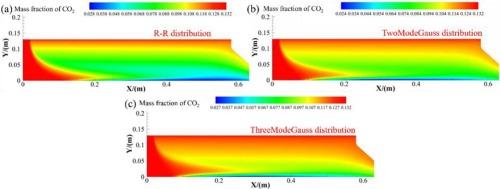固体火箭发动机环境下大质量铝颗粒和团聚体燃烧的欧拉-拉格朗日模拟
IF 4.6
2区 工程技术
Q2 ENGINEERING, CHEMICAL
引用次数: 0
摘要
在固体火箭燃烧室中,铝颗粒往往在燃烧表面附近聚集成较大的团块,这导致了铝在流动过程中的分布燃烧。这种分布方式影响了整个堆芯流动,增加了燃烧行为的复杂性。因此,在计算模型中考虑这种分布燃烧和团块形成的影响是至关重要的。本文在欧拉-拉格朗日模型的基础上,建立了考虑烟相和氧化铝帽的铝团燃烧模型,对颗粒分布燃烧进行了较为精确的预测。采用典型的电机装置,模拟了多相反应流场,捕捉了大团块在整个流场中持续燃烧的颗粒分布燃烧过程。在大颗粒群下,从108到1012,对铝颗粒群燃烧流进行了数值研究,揭示了不可忽视的颗粒群动力学,反应流场表现出明显的差异。研究了三种典型的团聚体粒度分布;对比结果表明,团聚体对燃烧效率和发动机性能有显著影响,并且粒径分布表现出不同粒径团聚体的综合影响,这表明在每种分布中确定优势粒径的重要性。这项工作提供了有价值的见解,如何团聚大小和分布影响燃烧行为在真实的电机条件下,强调将这些因素纳入燃烧建模的重要性,以更准确地预测电机性能。本文章由计算机程序翻译,如有差异,请以英文原文为准。

Euler-Lagrange simulation of massive aluminum particles and agglomerates combustion in a realistic solid rocket motor environment
In a solid rocket combustor, the aluminum particles often aggregate into larger agglomerates near the burning surface, which contributes to the distributed combustion of aluminum during the flow. This distributed manner influences the overall core flow and adds complexity to the combustion behavior. Therefore, it is crucial to account for the effects of this distributed combustion and agglomerate formation in computational modeling. In this work, based on the Euler-Lagrange model, the aluminum agglomerate combustion model is established with consideration for the smoke phase and alumina cap, which would provide a precise prediction of the particle distributed combustion. Using a typical motor setup, the multiphase reacting flow field is simulated and the particle distributed combustion is captured as the large agglomerates continue to combust in the whole flow field. With massive particle group, from 108 to 1012, the aluminum particle group combusting flow is numerically studied and reveals the non-neglected particle collective dynamics, as the reacting flow field shows obvious difference. Three typical agglomerate size distributions are investigated; the comparative results indicate the agglomerate has significant effects on combustion efficiency and motor performance, and the size distribution shows combined effects from the different size agglomerates, which indicates the importance of identifying the predominant sizes in each distribution. This work provides valuable insights into how agglomerate size and distribution influence combustion behavior in real motor conditions, emphasizing the importance of incorporating these factors into combustion modeling for more accurate predictions of motor performance.
求助全文
通过发布文献求助,成功后即可免费获取论文全文。
去求助
来源期刊

Powder Technology
工程技术-工程:化工
CiteScore
9.90
自引率
15.40%
发文量
1047
审稿时长
46 days
期刊介绍:
Powder Technology is an International Journal on the Science and Technology of Wet and Dry Particulate Systems. Powder Technology publishes papers on all aspects of the formation of particles and their characterisation and on the study of systems containing particulate solids. No limitation is imposed on the size of the particles, which may range from nanometre scale, as in pigments or aerosols, to that of mined or quarried materials. The following list of topics is not intended to be comprehensive, but rather to indicate typical subjects which fall within the scope of the journal's interests:
Formation and synthesis of particles by precipitation and other methods.
Modification of particles by agglomeration, coating, comminution and attrition.
Characterisation of the size, shape, surface area, pore structure and strength of particles and agglomerates (including the origins and effects of inter particle forces).
Packing, failure, flow and permeability of assemblies of particles.
Particle-particle interactions and suspension rheology.
Handling and processing operations such as slurry flow, fluidization, pneumatic conveying.
Interactions between particles and their environment, including delivery of particulate products to the body.
Applications of particle technology in production of pharmaceuticals, chemicals, foods, pigments, structural, and functional materials and in environmental and energy related matters.
For materials-oriented contributions we are looking for articles revealing the effect of particle/powder characteristics (size, morphology and composition, in that order) on material performance or functionality and, ideally, comparison to any industrial standard.
 求助内容:
求助内容: 应助结果提醒方式:
应助结果提醒方式:


